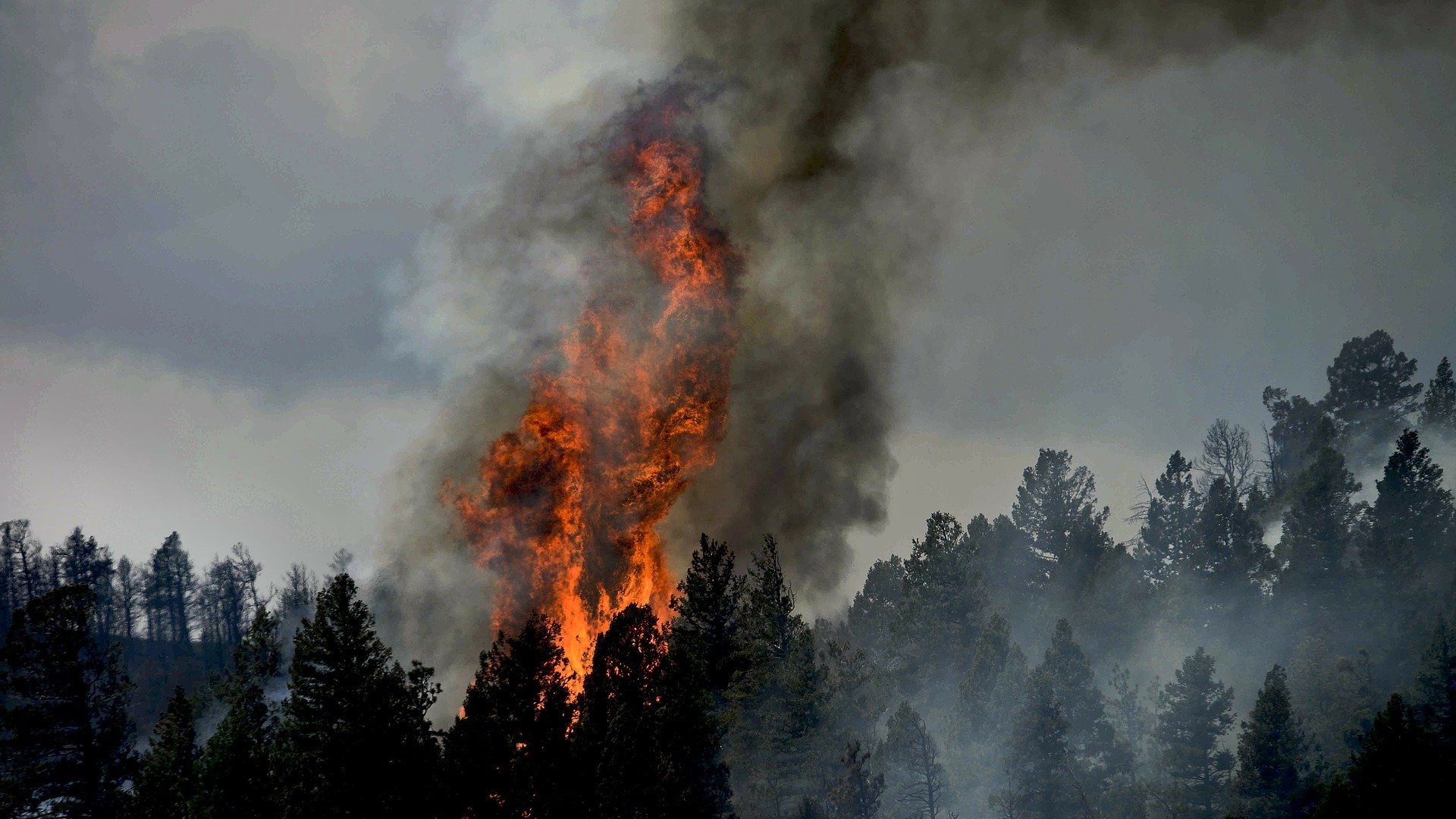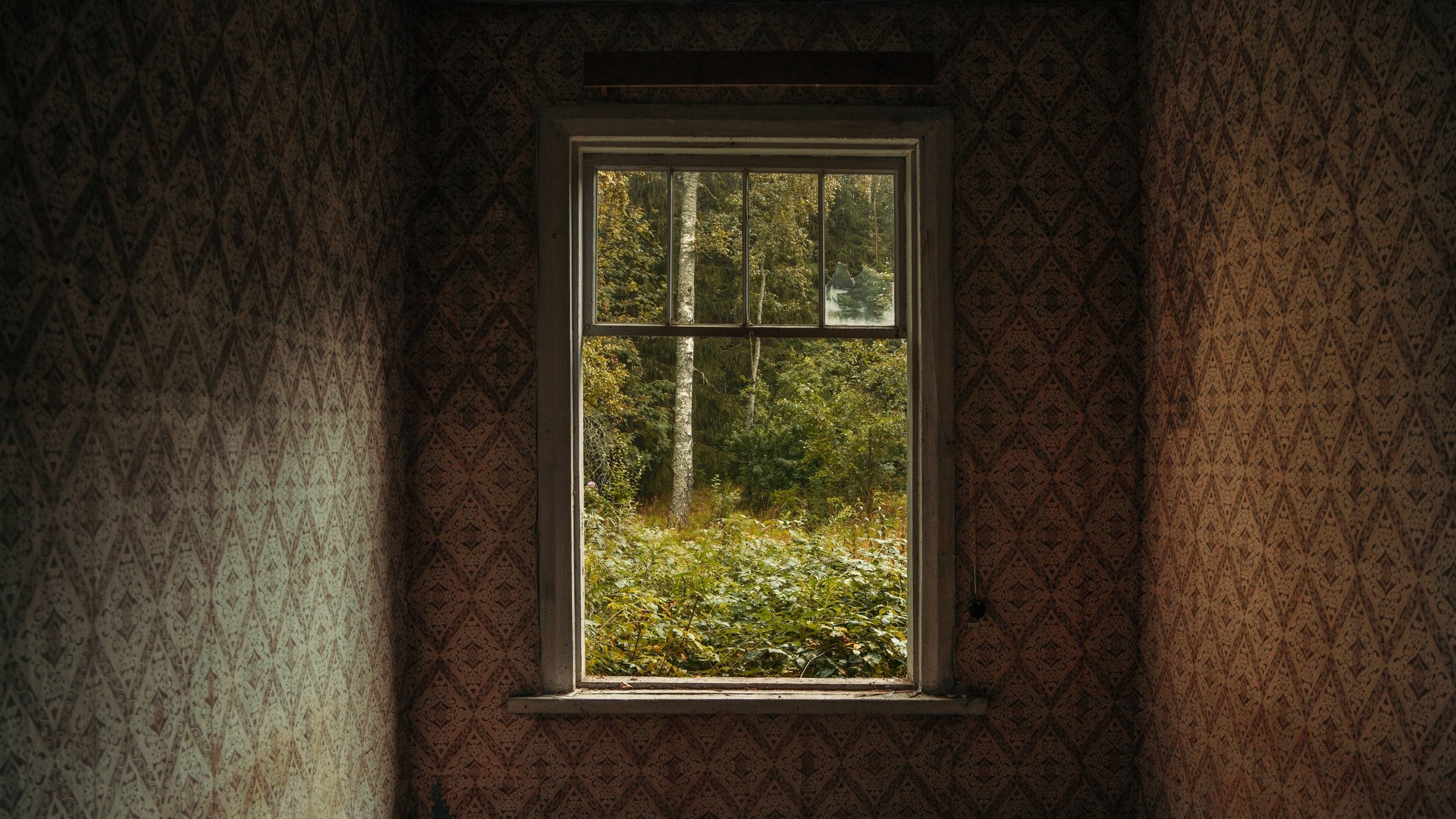Climate Despair and Our Death Wish
January 20, 2022 | By Sharla Moody BK ‘22
image description: scarlet flames and thick smoke rise from a shadowy forest into the turbulent sky.
This piece was written at the Veritas Forum 2020, an annual writing program offered by the Augustine Collective. Students from various universities work with writing coaches to write articles about virtue in the sciences or social sciences.
Water surges past the Statue of Liberty’s waist, empties into the crowded rush hour streets of Manhattan. Cars, trucks, and buses surf on the wall of filthy water bearing down on terrified bystanders. The sky erupts with hail the size of basketballs, indiscriminately falling on people frantically running to take shelter. Enormous tornados engulf entire skyscrapers in Los Angeles, spitting rubble down onto screaming bystanders, the carnage raining down beyond any Old Testament judgment.
Fortunately, these are just fictional scenes from the 2004 disaster film The Day After Tomorrow, a movie premised on sudden and catastrophic climate change brought about by the excessive release of greenhouse gases, manifesting in the form of a global storm system that throws the world into a new ice age. [1] Though decadent in the devastation it presents, The Day After Tomorrow is far from an anomaly in its genre. Ten years later, Bong Joon-ho’s Snowpiercer set the entire world in the midst of an ice age brought about by failed attempts to artificially cool the Earth’s global temperature. 2012’s Chernobyl Diaries fantasized about mutants hunting tourists at the site of the nuclear disaster. In 2017, Paul Schrader wrote and directed First Reformed, about a pastor counselling a despairing activist-turned-ecoterrorist. Disaster films focus on the annihilation of civilization, usually resulting from the ignorance, inaction, and danger posed by the human race. While initially it seems that such movies fill a demand for a sort of grimy, masochistic reflection and entertainment, it becomes apparent that the genre seeks answers to the catastrophe predicted to lie in the future. And, if popular culture is anything to go off, the general attitude seems pretty bleak.
Climate despair might be the product of climate disaster films, but there’s also something deeper at play. Psychology isn’t affected purely by fictional events in fictional movies. While the disaster genre loves to exaggerate, these exaggerations originate from places of real fear for the future of humanity. For example, The Day After Tomorrow begins with an earnest scientist named Jack Hall (played by Dennis Quaid) warning dismissive world leaders of global warming and greenhouse gas emissions at a UN conference, a scene that parallels the U.S. decision to withdraw from the 2015 Paris Climate Agreement, which seeks to limit the global average temperature to mitigate the effects of global warming. Popular culture reflects these climate-related fears. Though disaster films might hyperbolize the immediate effects of climate change, the future they paint is not necessarily inconceivable to the despairing climate activist, especially when their propositions are rooted in the real world’s response to global warming.
First Reformed begins with climate despair at its premise, and the film was the first that I encountered to address the phenomenon. Reverend Toller, the film’s protagonist, counsels a depressed climate activist who “thinks it’s wrong to bring a child into this world” and tries to persuade his pregnant wife to procure an abortion. [2] The activist agonizes over the human race’s self-destruction and the havoc wreaked on the entirety of nature by global warming. This despair is not unique to fiction, though. A 2019 Vice article details suicidal ideation, anxiety, and alienation experienced as a result of fears from global warming. [3] A 2007 Australian survey found that “[a] quarter of children are so troubled about the state of the world that they honestly believe it will come to an end before they get older”. [4] According to an article published by Yale Climate Connections, a climate initiative directed by a professor at the Yale School of Forestry and Environmental Studies, “[w]atching or reading about climate change and natural disasters on the news…can cause anxiety, depression, secondary trauma, and other psychological conditions.” [5] Nobel Prize-nominated activist Greta Thunberg reported becoming depressed about the state of the world and climate activism. [6] “I stopped talking, I stopped eating,” Thunberg said in a 2018 TEDx Talk. “In two months, I lost about ten kilos of weight….We've had thirty years of pep-talking and selling positive ideas. And I'm sorry, but it doesn't work. Because if it would have, the emissions would have gone down by now—they haven't.” In a 2019 interview, she stated that when she was eight years old, she “sort of caught up with reading about it [climate change] and [she] understood and that made [her] very depressed”. [7] Is it difficult to imagine that activists and youth would be plagued by such fears, when headlines titled “New Report Suggests ‘High Likelihood of Human Civilization Coming to an End’ Starting in 2050” [8] and “Earth Will Take 100,000 Years to Recover From Global Warming, say Geologists” [9] circulate on social media?
And still, we yearn for depictions of the apocalypse. The Day After Tomorrow is masochism at its most decadent, large-scale format. Its formulas hammer human irresponsibility into the mind of the viewer for simple entertainment. The disaster genre teaches that there is nothing that can be done to prevent the looming crisis, and only heroes can prevail through a mix of scientific knowledge, macho bravery, and good fortune. In The Day After Tomorrow, Jack treks from Washington, D.C. to New York to reunite with his son, Sam, who was stranded when the storms first struck. At one point, Jack uses the body of his unconscious companion to break into an abandoned Wendy’s to take shelter. Inside, the deep fryer is somehow still operable, and he is able to shoot flames out of it for warmth. Meanwhile, in New York, Sam takes shelter with various others in the New York Public Library just as floodwaters devour the neighboring Bryant Park. When a girl in the library gets an infection, Sam and a few of his friends take to the streets to find penicillin. Along the way, they must dodge hungry wolves escaped from Central Park Zoo and return before a deep freeze sets in, so cold that a flag flying is crystalized in the wind. These are the fortunate people who survive the apocalypse, and writer and director Roland Emmerich is more aware of their humanness than he is of the personhood of the newscaster slammed by an airborne roof while broadcasting live during a tornado and the businessman killed running for shelter from hail. The film almost justifies the gratuity of their deaths. Fictional climate disasters bring detached judgment down onto unsuspecting individuals who are enablers and consumers of the system that brought such catastrophe, complicit in the calamities that killed them. Though their deaths are horrifying, they are reduced to spectacle entertainment. And while I shuddered to imagine their fates, a part of me—the part of me that paid money to watch the movie—felt a sort of perverse relief. While my life is far from perfect, it’s not nearly as bad as that in the movies. There’s also a sense of catharsis that comes from watching artificial, CGI-manufactured carnage: some deep part of me has a death wish, a desire to watch all of civilization crumble, and it frightened me to realize that I am only aware of this desire when I watch disaster movies. I can’t be the only one: The Day After Tomorrow earned over half a billion dollars at the box office. [10]
Of course, transposing these emotions onto real events yields horrendous consequences. Who can look at post-Katrina New Orleans and declare that the people there deserved the financial, social, and mental toll caused by the hurricane because they participate in an industrialized, polluting world, when evidence suggests that global warming is making hurricanes more powerful? [11] Such an attitude, if expressed, should be immediately corrected. But the obsession with secondhand tribulation is far enough removed that it permits laughter and little introspection. The despair that disaster movies should wrought is ignored: why weep for fictional people in fictional disasters not expected to occur in the real world for decades, when weeping over bankruptcy or a medical diagnosis is more immediate and personal? In his lecture accepting the 1970 Nobel Prize in Literature, Russian writer Alexandr Solzhenitsyn said,
And if there are not many such different scales of values in the world, there are at least several; one for evaluating events near at hand, another for events far away…Which is why we take for the greater, more painful and less bearable disaster not that which is in fact greater, more painful and less bearable, but that which lies closest to us. Everything which is further away, which does not threaten this very day to invade our threshold – with all its groans, its stifled cries, its destroyed lives, even if it involves millions of victims – this we consider on the whole to be perfectly bearable and of tolerable proportions. [12]
In this sense, the despairing climate activist should be applauded for his ability to mourn for a tragedy not anticipated to occur for decades, and one that is not promised to affect his personal, singular life. Teenagers, after all, do not ordinarily grieve for their deaths far-off in the future, though all evidence points to their inevitabilities.
Climate activism may have an alarmist edge that hampers change and fosters despair. Writing for Vice in 2018, columnist Mike Pearl decried “climate edgelords,” saying, “Apathy and cynicism may feel like a very mentally healthy form of acceptance of our collective fate—but these attitudes are actually just abdication of responsibility.” [13] Edgelords, he argues, espouse the most pessimistic views towards climate change and argue that it is too late to achieve real change that might deter the anticipated disastrous future. But whether these claims against alarmism are true is a critical question to ask in regards to climate despair, another query that comes out of this phenomenon is the human response to tangible existential threats. If climate change is as threatening as many claim—that the world will look unrecognizable by 2050, including the addition of climate refugees, massive droughts, and the vanishing of coastal cities—then it is hard to fault those who suffer from climate despair. But is climate despair actually a new, never-before-experienced reaction to a looming catastrophe, or is it rather the superimposition of the despair that has plagued humanity since the dawn of time onto the current crisis?
Despair is not new, but this environmentally conscious form of it is perhaps one of its more universal manifestations. While despair does not necessarily indicate some truth about the world, climate despair results from the belief that the world might end in our lifetimes, and this belief has grave effects on the behavior and emotional health of activists and youth who come of age under the shadow of annihilation. Like reactions to war or natural disaster, climate despair mourns the loss of the world for the whole of humanity and nature. And though despair has been documented since the dawn of time, threats like those posed by war, economic depression, and climate change merely give despair a direction, or at least a source that can be uprooted, mended, and hopefully in the future, only remembered.
Despair is the most pessimistic reaction to hardship, but it is not the only response to existential threat. And, even regarding a problem that appears as complex and dangerous as climate change, it is not the proper response. Despair accepts defeat, and though some certainly give in to this, their surrenders are not reflected yet in real change. Rather than despair at reports, more and more people have mobilized to voice their concerns, demand change, and commit to that change themselves. This includes some high-profile protests that have put pressure on institutions to divest from fossil fuel industries. [14] Broadly speaking, this has been reflected in practically every movement that focuses on implementing change or correcting injustices.
In the biblical Book of Job, Job grieves the loss of his fortune and deaths of his children. The author describes Job’s response to learning of these tremendous losses: “Then Job arose and tore his robe and shaved his head and fell on the ground and worshiped. And he said, ‘Naked I came from my mother’s womb, and naked shall I return. The Lord gave, and the Lord has taken away; blessed be the name of the Lord.’ In all this Job did not sin or charge God with wrong.” [15] Even when faced with a deficit I cannot and hopefully never will fully understand, Job turns in his mourning to praise God. And while no end to despair is promised to Job, and while nothing could ever compensate for the loss of his children, Job worshiped. There is no mortal end to the tremendous pain he experienced, and still he sought something beyond just himself.
This is not to say that it is wrong to mourn tragedies. Jesus, when encountering Mary and Martha after their brother Lazarus’s death, wept. However, stagnating in grief and anxiety does nothing to reduce sorrow or alleviate damage. This is true even for issues that are far bigger than any individual. The poet Aeschylus wrote,“In our sleep, pain which cannot forget falls drop by drop upon the heart until, in our own despair, against our will, comes wisdom through the awful grace of God.” [16] For the downtrodden, even if only for the sake of positive mental health amidst existential threat, there are two paths forward, defeat or perseverance. And in the bottom of despair, pressing forward is the only way to pursue change, or even in cases where actions fail to yield the desired outcomes, to cling to a sense that man is not obsolete in the face of catastrophe. If we face existential dread, let us pray that it at least makes us wiser, moved, better.
[1] The Day After Tomorrow. Directed by Roland Emmerich, performances by Dennis Quaid, Jake Gyllenhaal, Emmy Rossum, Arjay Smith, Austin Nichols, and Kenneth Welsh, 20th Century Fox, 2004.
[2] First Reformed. Directed by Paul Schrader, performances by Ethan Hawke and Philip Ettinger, A24, 2017.
[3] Pearl, Mike. “‘Climate Despair’ Is Making People Give Up on Life.” Vice, 11 July 2019, https://www.vice.com/en_us/article/j5w374/climate-despair-is-making-people-give-up-on-life.
[4] Tucci, J., Carr, and Mitchell. “Children’s fears, hopes, and heroes: Modern childhood in Australia.” Australian Childhood Foundation, June 2007. https://www.researchgate.net/profile/Chris_Goddard/publication/264546580_Children's_Fears_hopes_and_heroes_Modern_childhood_in_Australia/links/53e824620cf21cc29fdc348f.pdf.
[5] Harrington, Samantha. “How climate change affects mental health.” Yale Climate Connections, 4 Feb 2020, https://www.yaleclimateconnections.org/2020/02/how-climate-change-affects-mental-health/.
[6] Thunberg, Greta. “School strike for climate change – save the world by changing the rules.” TEDx Talks, 12 Dec 2018, https://www.youtube.com/watch?v=EAmmUIEsN9A.
[7] Hammond, Clive. “Greta Thunberg depression: Activist’s devastating confession on health exposed.” Express, 12 Mar 2020, https://www.express.co.uk/news/world/1254334/Greta-Thunberg-latest-news-climate-change-activist-mental-health-depression-update.
[8] Ahmed, Nafeez. “New Report Suggests ‘High Likelihood of Human Civilization Coming to an End’ Starting in 2050.” Vice, 3 Jun 2020, https://www.vice.com/en_us/article/597kpd/new-report-suggests-high-likelihood-of-human-civilization-coming-to-an-end-in-2050?f.
[9] https://www.joboneforhumanity.org/7_shocking_climate_change_headlineseep.
[10] “The Day After Tomorrow.” Box Office Mojo, https://www.boxofficemojo.com/release/rl1716291073/.
[11] Berardelli, Jeff. “How climate change is making hurricanes more dangerous.” Yale Climate Connections, 8 July 2019, https://www.yaleclimateconnections.org/2019/07/how-climate-change-is-making-hurricanes-more-dangerous/?gclid=EAIaIQobChMI8vzRs7TU6QIVRfvjBx2OdAAKEAAYAi AAEgJlmvD_BwE.
[12] Solzhenitsyn, Alexandr. “Nobel Lecture.” The Nobel Prize, 1970, https://www.nobelprize.org/prizes/ literature/1970/solzhenitsyn/lecture/,
[13] Pearl, Mike. “Climate Change Edgelords Are the New Climate Change Deniers.” Vice. 12 Oct 2018, https://www.vice.com/en_us/article/pa9vg8/climate-change-edgelords-are-the-new-climate-change-deniers.
[14] Pavilonis, Valerie, and Matt Kristofferson. “Yale and Harvard students delay second half of The Game with divestment protest.” Yale Daily News, 23 Nov 2019, https://yaledailynews.com/blog/2019/11/23/y ale-and-harvard-students-delay-second-half-of-the-game/.
[15] The Book of Job 1:20-22, English Standard Version.
[16] Aeschylus, the Oresteia, the Agamemnon, lines 206-210.




December 15, 2023 | Yoska Guta TD ‘25
For some people, this seemingly harmless source of self-soothing can easily become a vicious cycle of self-dependence. Sure, one could, in theory, celebrate every positive thing that comes their way as a victory of their positive thoughts. But, they must equally bear the brunt of every unwanted outcome, as their confidence lies solely within their thoughts. Yet, they mustn’t ruminate on these negative outcomes for too long, out of fear of perpetuating such outcomes through their negative thoughts. In the long run, this circular ideology has the potential to drive people further into cycles of ignorance and blame.